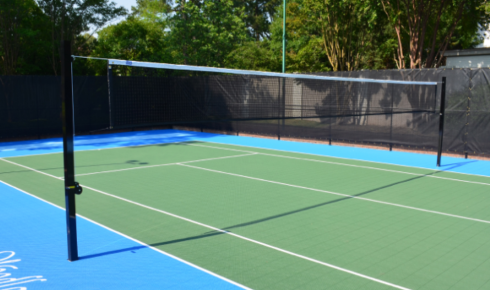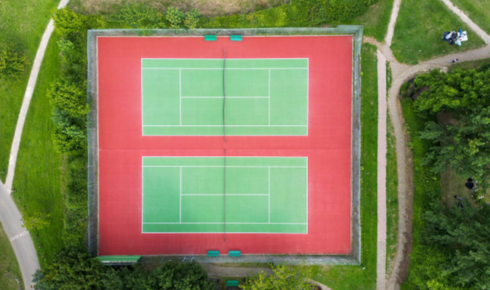
Volleyball thrives in open spaces—from school playgrounds to beachfront resorts—and the demand for durable outdoor volleyball court flooring has never been greater. Selecting the right volleyball court materials is about far more than aesthetics; it shapes ball bounce, player safety, maintenance costs, and the court’s overall lifespan. In this guest post, we’ll dive deep into standard court sizes, performance‑driven surfacing systems, construction best practices, and maintenance tips, so you can create a world‑class volleyball venue that stands up to India’s diverse climate.
1. Why Prioritise Professional Outdoor Volleyball Court Construction
- Safety First: Proper cushioning, grip, and evenness reduce ankle twists, knee strain, and falls.
- Consistent Play: Regulation dimensions and uniform bounce keep serves, sets, and spikes predictable.
- Lower Lifetime Cost: Investing in premium sports flooring contractors and high‑grade materials means fewer resurfacing cycles and repairs.
- Multi‑Sport Flexibility: Many synthetics double as surfaces for futsal, basketball, or pickleball—maximising ROI on one slab of concrete.
2. Regulation Volleyball Court Dimensions at a Glance
| Element | Measurement | Notes |
| Court length | 18 m | Free‑play zones extend 3–5 m beyond the lines |
| Court width | 9 m | Sidelines must be clearly marked with UV‑stable paint |
| Net height | 2.43 m (men) / 2.24 m (women) | Steel or aluminium posts set in ground sleeves |
Accurate marking ensures that local tournaments and school competitions meet Asian Volleyball Confederation requirements.
3. Key Performance Factors for Outdoor Volleyball Court Flooring
- Shock Absorption: Look for systems offering 20 %–30 % force reduction to reduce joint impact.
- Ball Response: A FIVB‑compatible rebound ensures predictable rallies.
- Slip Resistance: Textured finishes and silica sand infills maintain grip even when surfaces are damp.
- UV & Weather Resistance: In India’s searing summers and monsoons, acrylic topcoats with light‑fast pigments prevent fading and delamination.
4. Volleyball Court Materials—Layer by Layer
4.1 Sub‑Base: The Foundation
- Compacted Earth & Stone Dust: Provides drainage and stability.
- Reinforced Concrete Slab (100–125 mm): Laser‑levelled for ±3 mm flatness, finished with a 1 % cross‑fall to evacuate storm water.
4.2 Cushion Coating
Cushion Coating is acrylic elastomeric blends or prefabricated rubber mats can be trowel‑applied to introduce resilience, easing the stress of dives and jump serves.
4.3 Surfacing & Color Coats
Highly pigmented acrylic systems—often 2–3 coats at 0.8–1.2 mm each—deliver abrasion resistance and vibrant hues (typically terracotta, ocean blue, or custom school colours).
4.4 Line Marking
High‑solids polyurethane or acrylic line paint, mixed with finely graded silica, produces crisp, skid‑resistant boundaries that outlast cheaper latex alternatives.
5. Popular Outdoor Volleyball Court Flooring Options
5.1 Acrylic Synthetic Cushion Systems
- Acrylic Synthetic Surface includes Multi‑layer build (primer, resurfacer, three cushion coats, two colour coats, line marking).
- Expected life cycle: 6–10 years with minor re‑top every 4–5 years.
5.2 Modular Polypropylene Tiles
- Interlocking 305 mm squares atop a concrete pad.
- Quick replacement of damaged tiles; open‑grid design drains rainwater.
- Slightly higher ball rebound; may require periodic leaf blowing to avoid grit build‑up.
5.3 Sand‑Court Transformation
- Perfect for resorts or coastal schools: a compacted sand bed with boundary lines pegged into place.
- Requires weekly raking and top‑up to counteract erosion.
6. Step‑by‑Step Construction Workflow
- Site Survey & Drainage Plan – Ensure sub‑soil water table won’t undermine the slab.
- Earthwork & Sub‑Base – Compaction meets 95 % Proctor density.
- Formwork & Concrete Pour – Expansion joints every 6–8 m to mitigate cracking.
- Curing & Surface Grinding – Eliminates laitance and opens pores for primer adhesion.
- Acrylic Layering – Primer → Resurfacer → Cushion coats → Colour → Lines.
- Accessories – Net posts, perimeter chain‑link fencing (3 m height), LED floodlights if night play is planned.
7. Maintenance & Longevity Strategies
- Weekly Sweeping/Blowing removes grit that can abrade color coats.
- Quarterly Pressure Washing at <1,500 psi keeps algae away without stripping acrylic.
- Annual Inspection for hairline cracks; fill with acrylic binder and silica blend.
- Five‑Year Re‑Top – A fresh colour coat revives aesthetics and traction.
Routine care extends surface life to over a decade—critical for budget‑conscious institutions.
8. Budgeting & Contractor Selection
| Cost Component | Typical Range (INR per m²) | Notes |
| Concrete base | 450–650 | Regional cement pricing impacts variation |
| Acrylic cushion system | 550–800 | Includes materials and labour |
| Modular tiles | 950–1,400 | Higher initial outlay, lower repainting costs |
| Accessories (posts, fencing, lights) | Lump‑sum 2 – 4 L | Depends on pole specs and galvanising quality |
Pro Tip: Short‑list sports flooring contractors with FIBA, ITF, or FIVB project experience. Demand site visits to existing courts and insist on written warranties (minimum five years on surface adhesion and fading).
Conclusion
Selecting optimal volleyball court materials and a high‑quality outdoor volleyball court flooring system is the cornerstone of a safe, vibrant, and durable playing surface. From the first soil test to the final line‑paint stroke, every decision—from concrete mix to acrylic pigment—directly influences player experience and maintenance budgets. With professional planning, resilient surfacing, and disciplined upkeep, you can deliver a volleyball arena that fuels community spirit for years, weathering spikes, serves, and tropical monsoons alike.


